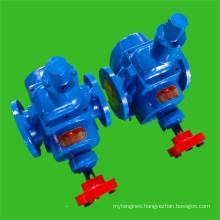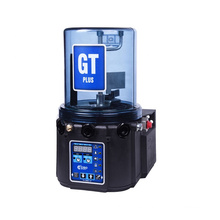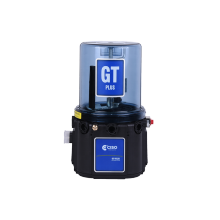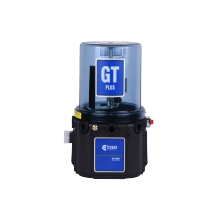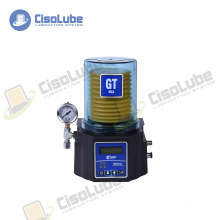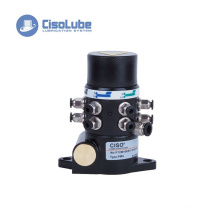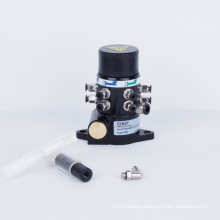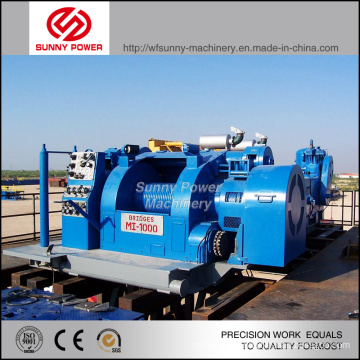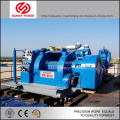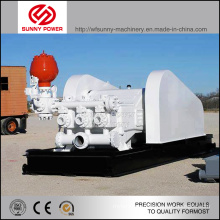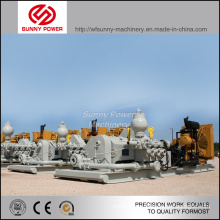Diesel Engine Driven Mud Pump Working for Drilling Industry
Basic Info
Model No.: 800KW
Product Description
Model NO.: 800KW Max.Capacity: 200-300 l/min Type: Diesel Engine Driven Certification: ISO Trademark: Sunny Specification: 500-1000KW HS Code: 8413709990 Max.Head: 1500m Pressure Medium: Mud Position of Pump Shaft: Horizontal Pressure: 150bars Transport Package: Plastic Film Origin: China Product Description
Horizontal Triplex BW Series Three Cylinder Single Acting Piston Drilling Mud Pump
BW-150 mud pump is a horizontal reciprocating single-acting triplex piston pump with eight kinds of pressure and discharge available for use. This mud Water Pump is commonly applied to deliver drilling fluids into drill hole in the drilling engineering of geology, and it is fit for diamond drilling with small aperture and a maximum depth of 1500 m. It is also perfect for middle and low pressure cement slurry perfusing.
Applications
This mud water pump is extensively utilized in industries including geology, coal, building, metallurgy, chemicals, railway, water conservancy, oil and other fields.
Features
This mud water pump is designed with multiple shifts for flexible speed and displacement adjustment. With compact structure and light weight, this reciprocating piston pump is also energy-saving, highly-effective and durable in use. In addition, it is easy to operate and convenient to maintain, keeping the maintenance cost low. This mud pump is primarily used as low and medium grouting pump in geological drilling, geological engineering construction and foundation treatment.
The drilling fluid used by this reciprocating piston pump shall not contain any chemical impurities that are corrosive to metals and rubber Parts, and the temperature of the fluid shall not exceed 50ºC. When using mud for flushing, the recommended proportion of water and mud is between 1.03 and 1.12, viscosity of mud between 18 and 25S, silt content lower than 4%, diameter of sand particles not exceed 3 mm, and PH value around 7 to 8. No tiny mud balls, weeds, leaves and other impurities are allowed in the mud.
Piston Pumps and Plunger Pumps Information
Piston pumps and plunger pumps are reciprocating positive displacement pumps that use a plunger or piston to move media through a cylindrical chamber. They are also called well service pumps, high pressure pumps, or high viscosity pumps because they can deliver high pump pressures and are capable of handling both viscous and solids containing media.
Operation
Piston pumps and plunger pumps are positive displacement pumps, meaning they use contracting and expanding cavities to move fluids. Specifically, they are reciprocating pumps, which have cavities that expand and contract in a reciprocating (back and forth; up and down) motion rather than a circular (rotary) motion. For more information about this category of pumps, please contact us via
Piston pumps and plunger pumps use a mechanism (typically rotational) to create a reciprocating motion along an axis, which then builds pressure in a cylinder or working barrel to force gas or fluid through the pump. The pressure in the chamber actuates the valves at both the suction and discharge points.
view full size image
Double-action plunger pump. Image Credit: pistonpump.org
Design
Piston pumps and plunger pumps can be distinguished by design based on type, pump action, and the number of cylinders.
Types
There are many types of piston pumps and plunger pump designs, but they all employ at least one piston moving in an enclosed cylinder. Specific types of designs include axial and radial piston pumps.
Axial piston pumps contain a number of pistons attached to a cylindrical block which move in the same direction as the block's centerline (axially). Much of the pressure and flow control circuitry can be included internally, allowing for reliable operation and simple design of the associated hydraulic system.
view full size image
Here is a video visual of an axial piston pump assembly:
adial piston pumps contain pistons arranged like wheel spokes around a cylindrical block. A drive shaft rotates this cylindrical block which pushes or slings the pistons, causing compression and expansion. The eccentricity between the piston housing and cylinder block centerlines determines the piston stroke. These pumps have a low noise level, very high loads at the lowest speeds, and high efficiency.
Pump Action
Pump action determines what directions the piston/plunger moves to perform fluid suction and discharge. The diagram below illustrates.
view full size image
Image Credit: Engineers Edge.
· Single acting pumps have one valve on each end, where suction and discharge take place in opposite directions.
· Double acting pumps utilize two valves on each end, allowing suction and discharge in both directions.
Number of Cylinders
The number of pump cylinders is the number of pumping cylinders in the pump. Increasing the number of pump cylinders increases the capacity of the pump.
· Simplex pumps have one cylinder.
· Duplex pumps have two cylinders.
· Multiplex pumps have more than two cylinders.
Specifications
The primary specifications to consider when selecting pumps are flowrate, stroke volume, pump head, pressure, horsepower, power rating, outlet diameter, and operating temperature.
Materials
The material(s) of a pump should be considered based on type of application. The base (casing) and housing (cylinder) materials should be of adequate strength and also be able to hold up against the conditions of its operating environment. Materials in contact with the pumped media (the plunger, discharge valves, and suction valves) need to be resistant to any corrosion induced by the fluid. Some materials used are listed below.
Cast iron provides high tensile strength, durability, and abrasion resistance corresponding to high pressure ratings.
Plastics are inexpensive and provide extensive resistance to corrosion and chemical attack.
Steel and stainless steel alloys provide protection against chemical and rust corrosion and have higher tensile strengths than plastics, corresponding to higher pressure ratings.
Other materials used in pump construction include:
· Aluminum
· Brass
· Bronze
· Ceramics
· Nickel-alloy
For more information on materials and other pump features,.
Contact us if you need more details on Mud Pump. We are ready to answer your questions on packaging, logistics, certification or any other aspects about Piston Mud Pump、Horizontal Mud Pump. If these products fail to match your need, please contact us and we would like to provide relevant information.
Horizontal Triplex BW Series Three Cylinder Single Acting Piston Drilling Mud Pump
BW-150 mud pump is a horizontal reciprocating single-acting triplex piston pump with eight kinds of pressure and discharge available for use. This mud Water Pump is commonly applied to deliver drilling fluids into drill hole in the drilling engineering of geology, and it is fit for diamond drilling with small aperture and a maximum depth of 1500 m. It is also perfect for middle and low pressure cement slurry perfusing.
Applications
This mud water pump is extensively utilized in industries including geology, coal, building, metallurgy, chemicals, railway, water conservancy, oil and other fields.
Features
This mud water pump is designed with multiple shifts for flexible speed and displacement adjustment. With compact structure and light weight, this reciprocating piston pump is also energy-saving, highly-effective and durable in use. In addition, it is easy to operate and convenient to maintain, keeping the maintenance cost low. This mud pump is primarily used as low and medium grouting pump in geological drilling, geological engineering construction and foundation treatment.
The drilling fluid used by this reciprocating piston pump shall not contain any chemical impurities that are corrosive to metals and rubber Parts, and the temperature of the fluid shall not exceed 50ºC. When using mud for flushing, the recommended proportion of water and mud is between 1.03 and 1.12, viscosity of mud between 18 and 25S, silt content lower than 4%, diameter of sand particles not exceed 3 mm, and PH value around 7 to 8. No tiny mud balls, weeds, leaves and other impurities are allowed in the mud.
| Model | BW-150 | |||
| Type | Horizontal single-acting triplex reciprocating mud pump | |||
| Stroke (mm) | 70 | |||
| Cylinder Dia. (mm) | 70 | |||
| Pump Speed (rpm) | 222 | 130 | 86 | 57 |
| Pressure (MPa) | 1.8 | 3.2 | 4.8 | 7.0 |
| Volumetric Efficiency (%) | 95 | |||
| Overall Efficiency (%) | 78 | |||
| Input Torque (Nm) | 150 | |||
| Rated Power (kW) | 7.5(motor) | |||
| Suction Pipe Dia. (mm) | 51 | |||
| Discharge Pipe Dia. (mm) | 32 | |||
| Max Suction Height.(m) | 2.5 | |||
| Weight.(kgs) | 516 (equipped with hydraulic motor) | |||
| Dimension (L *W * H) (mm) | 1870x790x995 | |||
Piston pumps and plunger pumps are reciprocating positive displacement pumps that use a plunger or piston to move media through a cylindrical chamber. They are also called well service pumps, high pressure pumps, or high viscosity pumps because they can deliver high pump pressures and are capable of handling both viscous and solids containing media.
| Advantages | Disadvantages |
| · Wide pressure range - can achieve very high pressures | · High operating and maintenance costs. |
| · Pressure can be controlled without affecting flow rate. | · Typically heavy and bulky |
| · Pressure and flow rate changes have little effect on performance. | · Typically only handles lower flow rates |
| · Capable of moving viscous fluids, slurries, and abrasives with proper Valve design. | · Pulsating flow |
Operation
Piston pumps and plunger pumps are positive displacement pumps, meaning they use contracting and expanding cavities to move fluids. Specifically, they are reciprocating pumps, which have cavities that expand and contract in a reciprocating (back and forth; up and down) motion rather than a circular (rotary) motion. For more information about this category of pumps, please contact us via
Piston pumps and plunger pumps use a mechanism (typically rotational) to create a reciprocating motion along an axis, which then builds pressure in a cylinder or working barrel to force gas or fluid through the pump. The pressure in the chamber actuates the valves at both the suction and discharge points.
view full size image
Double-action plunger pump. Image Credit: pistonpump.org
Design
Piston pumps and plunger pumps can be distinguished by design based on type, pump action, and the number of cylinders.
Types
There are many types of piston pumps and plunger pump designs, but they all employ at least one piston moving in an enclosed cylinder. Specific types of designs include axial and radial piston pumps.
Axial piston pumps contain a number of pistons attached to a cylindrical block which move in the same direction as the block's centerline (axially). Much of the pressure and flow control circuitry can be included internally, allowing for reliable operation and simple design of the associated hydraulic system.
view full size image
Here is a video visual of an axial piston pump assembly:
adial piston pumps contain pistons arranged like wheel spokes around a cylindrical block. A drive shaft rotates this cylindrical block which pushes or slings the pistons, causing compression and expansion. The eccentricity between the piston housing and cylinder block centerlines determines the piston stroke. These pumps have a low noise level, very high loads at the lowest speeds, and high efficiency.
Pump Action
Pump action determines what directions the piston/plunger moves to perform fluid suction and discharge. The diagram below illustrates.
view full size image
Image Credit: Engineers Edge.
· Single acting pumps have one valve on each end, where suction and discharge take place in opposite directions.
· Double acting pumps utilize two valves on each end, allowing suction and discharge in both directions.
Number of Cylinders
The number of pump cylinders is the number of pumping cylinders in the pump. Increasing the number of pump cylinders increases the capacity of the pump.
· Simplex pumps have one cylinder.
· Duplex pumps have two cylinders.
· Multiplex pumps have more than two cylinders.
Specifications
The primary specifications to consider when selecting pumps are flowrate, stroke volume, pump head, pressure, horsepower, power rating, outlet diameter, and operating temperature.
Materials
The material(s) of a pump should be considered based on type of application. The base (casing) and housing (cylinder) materials should be of adequate strength and also be able to hold up against the conditions of its operating environment. Materials in contact with the pumped media (the plunger, discharge valves, and suction valves) need to be resistant to any corrosion induced by the fluid. Some materials used are listed below.
Cast iron provides high tensile strength, durability, and abrasion resistance corresponding to high pressure ratings.
Plastics are inexpensive and provide extensive resistance to corrosion and chemical attack.
Steel and stainless steel alloys provide protection against chemical and rust corrosion and have higher tensile strengths than plastics, corresponding to higher pressure ratings.
Other materials used in pump construction include:
· Aluminum
· Brass
· Bronze
· Ceramics
· Nickel-alloy
For more information on materials and other pump features,.
Contact us if you need more details on Mud Pump. We are ready to answer your questions on packaging, logistics, certification or any other aspects about Piston Mud Pump、Horizontal Mud Pump. If these products fail to match your need, please contact us and we would like to provide relevant information.
Product Categories : Mining Machinery
Other Products
Hot Products
Yl 0.75kw Single Phase Double-Capacitor Asynchronous Motor (YL750)Cylinder Line Engine Spare Parts24kw-500kw High Quality Eapp Gas Generator SetFactory-Drict OEM Stainless Steel CNC Machining PartOriginal/OEM Ccec Dcec Cummins Diesel Engine Spare PartsEngine Spare Part PT Fuel Pump for Cummins Diesel EngineSpecifictions of Diesel Water Pumps From China for IrrigationWandi Diesel Engine for Generator 560kwWandi Diesel Engine for Pump (221kw/301HP) (WD258B22)Wandi Diesel Engine for Pump (309kw/421HP)Wheat ThresherSmall Wheat ThresherGeneratorDIESEL GENERATORchaff cutter india JF 40 MAX HIGH outputDiesel Engine India 18 H.P.
